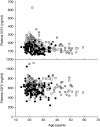Circulating IGF1 and IGF2 and SNP genotypes in men and pregnant and non-pregnant women
- PMID: 25117571
- PMCID: PMC4151385
- DOI: 10.1530/EC-14-0068
Circulating IGF1 and IGF2 and SNP genotypes in men and pregnant and non-pregnant women
Abstract
Circulating IGFs are important regulators of prenatal and postnatal growth, and of metabolism and pregnancy, and change with sex, age and pregnancy. Single-nucleotide polymorphisms (SNPs) in genes coding for these hormones associate with circulating abundance of IGF1 and IGF2 in non-pregnant adults and children, but whether this occurs in pregnancy is unknown. We therefore investigated associations of plasma IGF1 and IGF2 with age and genotype at candidate SNPs previously associated with circulating IGF1, IGF2 or methylation of the INS-IGF2-H19 locus in men (n=134), non-pregnant women (n=74) and women at 15 weeks of gestation (n=98). Plasma IGF1 concentrations decreased with age (P<0.001) and plasma IGF1 and IGF2 concentrations were lower in pregnant women than in non-pregnant women or men (each P<0.001). SNP genotypes in the INS-IGF2-H19 locus were associated with plasma IGF1 (IGF2 rs680, IGF2 rs1004446 and IGF2 rs3741204) and IGF2 (IGF2 rs1004446, IGF2 rs3741204 and H19 rs217727). In single SNP models, effects of IGF2 rs680 were similar between groups, with higher plasma IGF1 concentrations in individuals with the GG genotype when compared with GA (P=0.016), or combined GA and AA genotypes (P=0.003). SNPs in the IGF2 gene associated with IGF1 or IGF2 were in linkage disequilibrium, hence these associations could reflect other genotype variations within this region or be due to changes in INS-IGF2-H19 methylation previously associated with some of these variants. As IGF1 in early pregnancy promotes placental differentiation and function, lower IGF1 concentrations in pregnant women carrying IGF2 rs680 A alleles may affect placental development and/or risk of pregnancy complications.
Keywords: IGF1; IGF2; SNP genotype; human; pregnancy.
© 2014 The authors.
Figures



Similar articles
-
Association of Genetic Variants in IGF2-Related Genes With Risk of Metabolic Syndrome in the Chinese Han Population.Front Endocrinol (Lausanne). 2021 May 20;12:654747. doi: 10.3389/fendo.2021.654747. eCollection 2021. Front Endocrinol (Lausanne). 2021. PMID: 34093434 Free PMC article.
-
Maternal insulin-like growth factor 1 and 2 differentially affect the renin-angiotensin system during pregnancy in the guinea pig.Growth Horm IGF Res. 2015 Jun;25(3):141-7. doi: 10.1016/j.ghir.2015.02.001. Epub 2015 Feb 20. Growth Horm IGF Res. 2015. PMID: 25748140
-
Quantitative allele-specific expression and DNA methylation analysis of H19, IGF2 and IGF2R in the human placenta across gestation reveals H19 imprinting plasticity.PLoS One. 2012;7(12):e51210. doi: 10.1371/journal.pone.0051210. Epub 2012 Dec 5. PLoS One. 2012. PMID: 23227253 Free PMC article.
-
IGF2 DNA methylation is a modulator of newborn's fetal growth and development.Epigenetics. 2012 Oct;7(10):1125-32. doi: 10.4161/epi.21855. Epub 2012 Aug 21. Epigenetics. 2012. PMID: 22907587 Free PMC article.
-
High prevalence of the IGF2 rs680 GG polymorphism among top-level sprinters and jumpers.Growth Horm IGF Res. 2017 Dec;37:26-30. doi: 10.1016/j.ghir.2017.10.001. Epub 2017 Oct 3. Growth Horm IGF Res. 2017. PMID: 29107196
Cited by
-
Replication of GWAS Loci Revealed an Increased Risk of BET1L and H19 Polymorphisms with Intracranial Aneurysm.Dis Markers. 2019 Jun 2;2019:9490639. doi: 10.1155/2019/9490639. eCollection 2019. Dis Markers. 2019. PMID: 31275455 Free PMC article.
-
Long noncoding RNA variations in cardiometabolic diseases.J Hum Genet. 2017 Jan;62(1):97-104. doi: 10.1038/jhg.2016.70. Epub 2016 Jun 16. J Hum Genet. 2017. PMID: 27305986 Review.
-
Systemic and local lipid adaptations underlie regeneration in Drosophila melanogaster and Ambystoma mexicanum.NPJ Regen Med. 2024 Oct 29;9(1):33. doi: 10.1038/s41536-024-00375-x. NPJ Regen Med. 2024. PMID: 39472660 Free PMC article.
-
Association of Genetic Variants in IGF2-Related Genes With Risk of Metabolic Syndrome in the Chinese Han Population.Front Endocrinol (Lausanne). 2021 May 20;12:654747. doi: 10.3389/fendo.2021.654747. eCollection 2021. Front Endocrinol (Lausanne). 2021. PMID: 34093434 Free PMC article.
-
Genetic characteristics of competitive swimmers: a review.Biol Sport. 2022 Jan;39(1):157-170. doi: 10.5114/biolsport.2022.102868. Epub 2021 Apr 1. Biol Sport. 2022. PMID: 35173374 Free PMC article. Review.
References
-
- Yu H, Mistry J, Nicar MJ, Khosravi MJ, Diamandis A, van Doorn J, Juul A. Insulin-like growth factors (IGF-I, free IGF-I, and IGF-II) and insulin-like growth factor binding proteins (IGFBP-2, IGFBP-3, IGFBP-6, and ALS) in blood circulation. Journal of Clinical Laboratory Analysis. 1999;13:166–172. doi: 10.1002/(SICI)1098-2825(1999)13:4%3c166::AID-JCLA5%3e3.0.CO;2-X. - DOI - PMC - PubMed
-
- Juul A, Bang P, Hertel N, Main K, Dalgaard P, Jorgensen K, Muller J, Hall K, Skakkebaek N. Serum insulin-like growth factor-I in 1030 healthy children, adolescents, and adults: relation to age, sex, stage of puberty, testicular size, and body mass index. Journal of Clinical Endocrinology and Metabolism. 1994;78:744–752. doi: 10.1210/jcem.78.3.8126152. - DOI - PubMed
-
- Brabant G, von zur Mühlen A, Wüster C, Ranke MB, Kratzsch J, Kiess W, Ketelslegers JM, Wilhelmsen L, Hulthén L, Saller B, et al. Serum insulin-like growth factor I reference values for an automated chemiluminescence immunoassay system: results from a multicenter study. Hormone Research in Paediatrics. 2003;60:53–60. doi: 10.1159/000071871. - DOI - PubMed
-
- Yamamoto H, Sohmiya M, Oka N, Kato Y. Effects of aging and sex on plasma insulin-like growth factor I (IGF-I) levels in normal adults. Acta Endocrinologica. 1991;124:497–500. - PubMed
-
- Bidlingmaier M, Friedrich N, Emeny RT, Spranger J, Wolthers OD, Roswall J, Korner A, Obermayer-Pietsch B, Hubener C, Dahlgren J, et al. Reference intervals for insulin-like growth factor-1 (IGF-I) from birth to senescence: results from a multicenter study using a new automated chemiluminescence IGF-I immunoassay conforming to recent international recommendations. Journal of Clinical Endocrinology and Metabolism. 2014;99:1712–1721. doi: 10.1210/jc.2013-3059. - DOI - PubMed
LinkOut - more resources
Full Text Sources
Other Literature Sources
Research Materials
Miscellaneous

